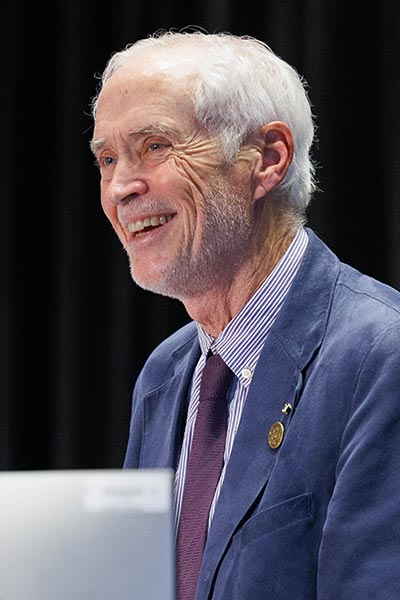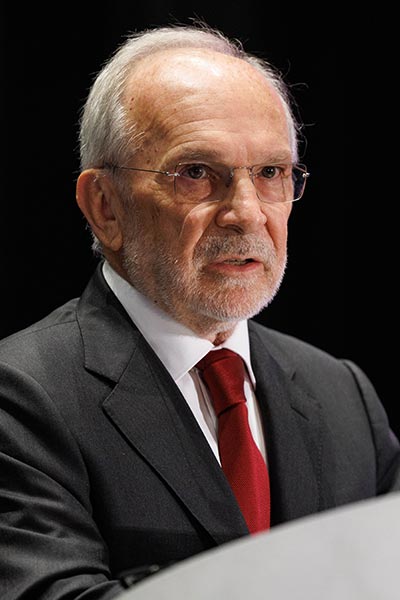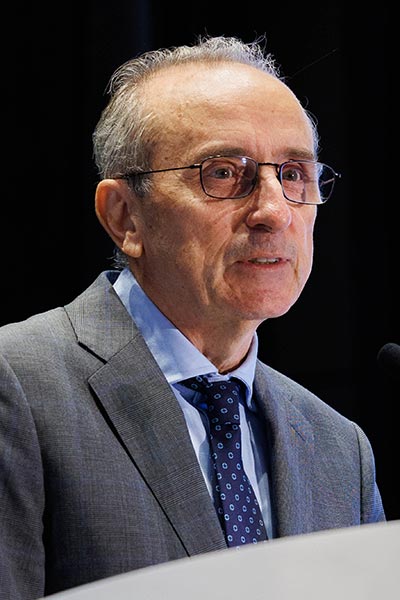Pezcoller Foundation award recipient discusses reprogramming the immune-evasive tumor microenvironment

Douglas Hanahan, PhD, FAACR, the Ludwig Distinguished Scholar at the Lausanne Branch of the Ludwig Institute for Cancer Research, is this year’s recipient of the Pezcoller Foundation-AACR International Award for Extraordinary Achievement in Cancer Research. As part of the honor, Hanahan gave a lecture on reprogramming the immune-evasive tumor microenvironment to enable immunotherapy at the AACR Annual Meeting.
“I’m speechless. It is quite a special honor to receive this award for many reasons,” he said.
The Pezcoller Foundation, a nonprofit dedicated to promoting biomedical research in cancer, and AACR have been giving this award every year to a scientist of international renown since 1998. Candidates must have either made a major scientific discovery in basic cancer research or provided significant contributions to translational cancer research. They also have to continue to be active in the research field with work that still promises to be substantive in advancing cancer care.

“We are extremely proud and grateful for AACR for this partnership that has enabled us to identify and reward the world’s best scientists in cancer research, as proven by the Nobel Prize subsequently won by four of them. This clearly testifies to the rigorous selection procedures and the excellence of the winners,” said Enzo Galligioni, MD, president of the Pezcoller Foundation.
The 2025 award recognizes how Hanahan’s discoveries in cancer research have led to numerous advances in care. While working at Cold Spring Harbor Laboratory, in the 1980s, he developed one of the first transgenic mouse models of cancer, which are today a staple of basic cancer research. His subsequent studies using mouse models helped lead to discoveries that include the “angiogenic switch” that promotes tumor progression and the concept that inflammation could promote tumor development.
That all being said, Hanahan may be best known throughout the oncology research community for his collaboration with Robert Weinberg, PhD, on their series of “The Hallmarks of Cancer” papers that laid out a framework for better understanding the complexity of the disease. The first one was published in 2000, with additional articles coming out in 2011, and 2022, as knowledge of cancer has evolved. Read more about the most recent update to “The Hallmarks of Cancer” on Cancer Research Catalyst, the AACR’s official blog.

“Dr. Hanahan also has been a pioneer in recognizing the importance of microenvironment in the progression of cancer and the role of various types of cells within that environment. In recent years, this has greatly contributed to the emerging field of cancer neuroscience, yet another hallmark, especially as it pertains to the functional importance in neuronal signaling pathways in cancer patients and metastases,” said Giulio Draetta, MD, PhD, chair of the session and a professor of genomic medicine at The University of Texas MD Anderson Cancer Center in Houston.
One of the areas Hanahan’s lecture focused on was reversing the systemic immunosuppression of a therapeutic oncoprotein vaccine in HPV16-driven squamous cell carcinomas. Hanahan noted that cervical cancer is the fourth leading cause of cancer deaths in women worldwide and is driven by two antigenic viral oncoproteins. Unfortunately, therapeutic vaccines have proven ineffective because of systemic immunosuppression.
Hanahan and his colleagues hypothesized that secretions from the tumor were causing this systemic immunosuppression. In presenting research simultaneously published in Cancer Discovery, Hanahan outlined how mouse models were used to determine that squamous cancer cells expressing the HPV16 oncogenes secrete IL-1 ligands—IL-1α, IL-33, and IL-36β. This helps expand the production of neutrophils that hinder T-cell development and impair immune responses. The researchers then used the model to determine that adding an anti-IL1RAP, an IL-1 family coreceptor antagonist, hinders this neutrophil expansion, helping the HPV16 E7 peptide vaccine provide an effective antitumor immune response that could be further sustained with an anti-CTLA4 therapy.
“We believe that a triplet of this [HPV16] oncoprotein vaccine, anti-IL1RAP and/or other pan-IL1 inhibitors, plus an anti-CTLA4 warrant consideration for clinical trials and so hopefully this work will inspire the consideration of that possibility,” said Hanahan.
He then switched his talk to discuss some preliminary data on a novel therapeutic approach for refractory glioblastoma through a triple combination that acted as immunotherapy, involving a vascular endothelial growth factor receptor, a tricyclic antidepressant, and an immune checkpoint inhibitor. Data hinted that this unique approach could be applicable to other cancer types as well.
In addition to the lecture at the AACR Annual Meeting, the award includes an unrestricted grant of €75,000 (roughly $85,000). Hanahan will formally receive the honor at the Pezcoller Foundation’s headquarters in Trento, Italy, in May, and will give two lectures at the Universities of Padova and of Trento during that same time period.
The recording of the full session is available for registered Annual Meeting attendees through October 2025 on the virtual meeting platform.
More from the AACR Annual Meeting 2025
View a photo gallery of scenes from Chicago, continue the conversation on social media using the hashtag #AACR25, and read more coverage in AACR Annual Meeting News.

